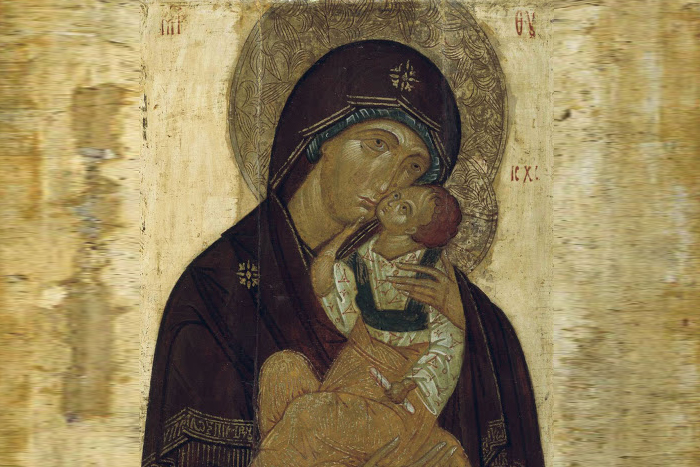 According to the story, the Tenderness icon of the Mother of God was painted in 1521 by hieromonk Arsenius Khitrosh as a copy of the Mother of God of Vladimir. In 1529-1570 the icon was brought in Pskov-Caves (Pskov-Pechersky) Monastery by merchants Basil and Feodor. Since that time the icon revealed many times its miraculous power and helped the Orthodox people.
According to the story, the Tenderness icon of the Mother of God was painted in 1521 by hieromonk Arsenius Khitrosh as a copy of the Mother of God of Vladimir. In 1529-1570 the icon was brought in Pskov-Caves (Pskov-Pechersky) Monastery by merchants Basil and Feodor. Since that time the icon revealed many times its miraculous power and helped the Orthodox people.Blind people were cured not once while praying in front of that icon. On May 28, 1587, when the icon was in Pskov, Maria Terentyeva, a widow who was blind for about three years, was cured after she had been praying in front of the Tenderness icon in the Holy Trinity Cathedral. Another miracle happened on March 26, 1603, when a peasant Potapiy Grigoryev was cured after six years of blindness. At the same time Ivan Supitsyn, a young man from the noble family, was cured from his ailment – the muscles of his left hand were paralyzed for two years.
The Pskov-Caves Tenderness icon of the Mother of God was especially worshipped during the reign of Ivan the Terrible in 1581, when Pskov and Pskov-Caves Monastery were sieged by the army of Polish king Stephen Bathory. Several days before the siege, the mother of God appeared to pious elder Doropheus. The Holy Mother of God warned him about the forthcoming disaster, explained that the reason of that misfortune, and told what they had to do in order to cope with it. Then the archbishop called the father superior of the Pskov-Caves Monastery and ordered to take the miraculous icon and serve the molebens in the places, which were chosen by the Mother of God Herself. 100,000 strong army of Stephen Bathory went to Pskov, as in case of success the king wanted to go further and conquer Novgorod and Moscow. The miraculous Tenderness icon was brought from the Monastery to the city of Pskov. The Polish army shelled the city and the Monastery with fiery cannonballs from the bell tower of the Mirozh Monastery. One of the cannonballs hit the icon of the Mother of God which was standing in the window opening of the wall, but it caused no damage to the icon and the people who were around. The siege lasted for 5 months, and the Poles tried 30 times to conquer Pskov, but did not manage to do that.
In the beginning of the 17th century the monastery saw the attacks of many other armies of Swedish, Lithuanian and Polish conquerors. In 1812 the French army threatened Russia. The army of Napoleon conquered Polotsk on August 17-18, 1812. The city of Pskov became endangered as well. The citizens asked to bring from the Monastery the Tenderness and Dormition icons of the Mother of God and a flag with the Image Not-made-by-hand. On October 7, a procession with the miraculous icons went through the city, and the same day the Russian army took back the city of Polotsk. A church in honor of Holy Archangel Michael (1815-1827) was built there to memorize that event, in which the Tenderness icon of the Mother of God is kept now.
In the 20th century Pskov-Caves Monastery had to go through two wars. But the ancient traditions preserving in the monastery were not forgotten even at that difficult for the monasticism time. In 1920 Pskov-Caves monastery and the city of Pechory were joined to the territory of Estonia until 1940. Due to that fact the monastery was not destroyed or damaged during the Soviet anti-Christian campaign. Pskov-Caves Monastery was one of few Russian Orthodox monasteries, which did not stop serving the Lord in the 20th century.
Translated by The Catalogue of Good Deeds
Source: https://azbyka.ru/days/ikona-umilenie-pskovo-pecherskaja
Source: https://azbyka.ru/days/ikona-umilenie-pskovo-pecherskaja




